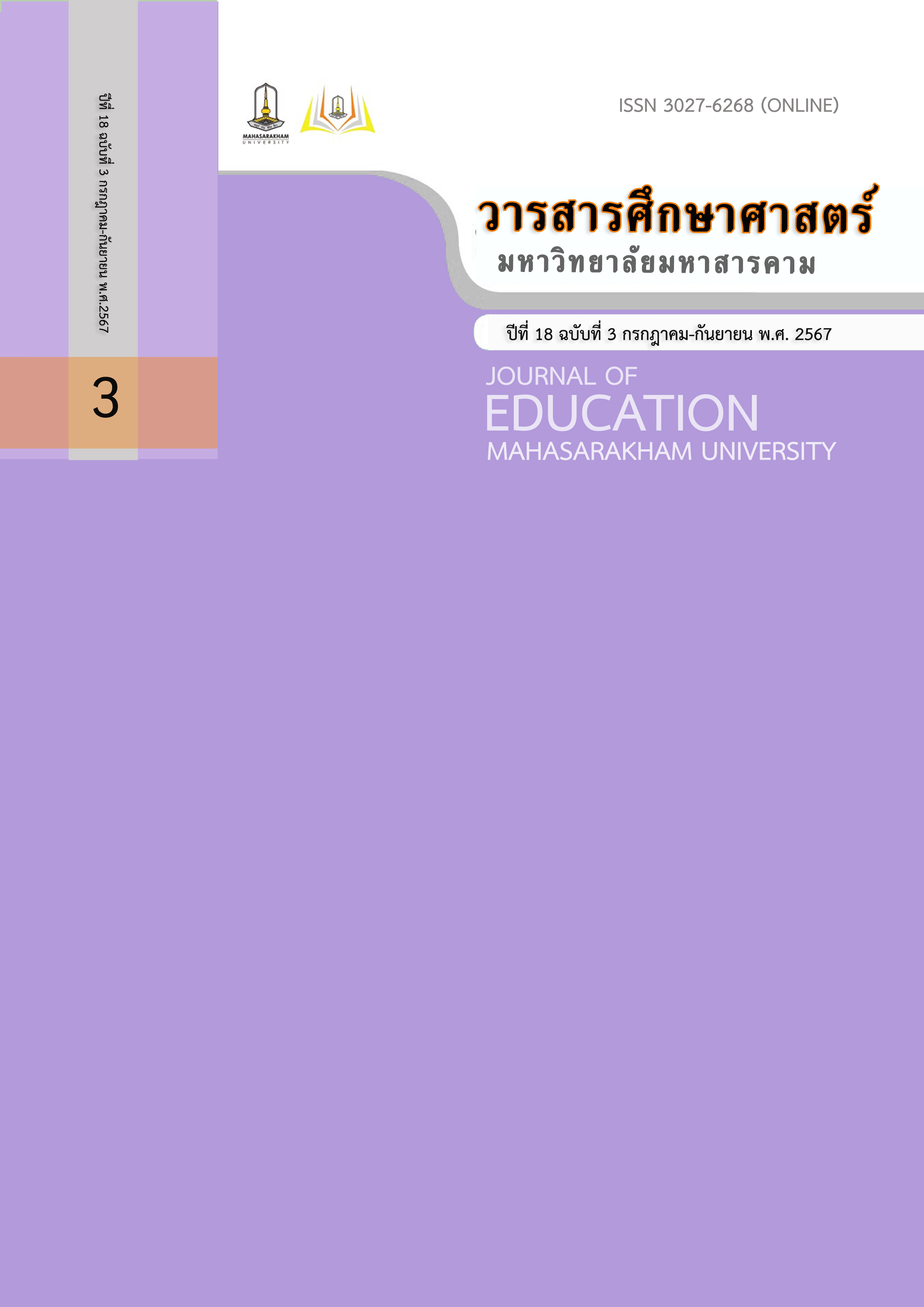The Effects of Flipped Classroom with Inquiry Method to Mathematical Problem Solving Ability in the Topic of Analytic Geometry for Mathayomsuksa 4 Students
Main Article Content
Abstract
The objectives of this research were to 1) study learning activities by using flipped classroom with inquiry method to achieve an efficiency of 70/70, 2) compare the learning achievements with the 70 precent criteria, 3) compare the mathematical problems solving ability with the 70 precent criteria, and (4) study students' satisfaction of learners from flipped classroom with inquiry method. The research sample were selected by using the cluster random sampling technique. There were 41 students from grade 10 in the second semester of academic year 2022. The research tools were: 1) 10 lesson plans using flipped classroom with inquiry method with the average appropriateness value of 4.53 considered as the most appropriate, 2) the multiple-choice tests to measure achievement with the discrimination from 0.34-0.73 and reliability of 0.84, 3) the essay tests to measure mathematical problems solving abilities with the item of difficulty from 0.44-0.54, the discrimination from 0.38-0.60 and reliability of 0.97, and 4) the questionnaires to measure the satisfaction of students with the discrimination from 0.64-0.89 and reliability of 0.96. The statistics used for analysing data were mean, percentage, standard deviation, and One Sample t-test. The results were revealed as follows: 1) flipped classroom with inquiry method was 79.13/76.36, 2) the students had a higher learning achievement than the percentage criteria of 70, which was statistically significant at the .05 level, 3) the students, had mathematical problem solving ability higher than the percentage criteria of 70, which was statistically significant at the .05 level, and 4) the students had a high level of satisfaction towards learning activities using flipped classroom with inquiry method.
Downloads
Article Details

This work is licensed under a Creative Commons Attribution-NonCommercial-NoDerivatives 4.0 International License.
References
กระทรวงศึกษาธิการ. (2560). หลักสูตรแกนกลางการศึกษาขั้นพื้นฐาน พุทธศักราช 2551 (ฉบับปรับปรุง 2560). กรุงเทพฯ: โรงพิมพ์ชุมนุมสหกรณ์การเกษตรแห่งประเทศไทย.
ชลธิชา วิมลจันทร์. (2563). การพัฒนาการเรียนรู้คณิตศาสตร์โดยใช้แนวคิดห้องเรียนกลับด้าน เรื่อง อัตราส่วน สำหรับนักเรียนชั้นมัธยมศึกษาปีที่ 1. วิทยานิพนธ์ปริญญาครุศาสตร์มหาบัณฑิต สาขาวิจัยหลักสูตรและการสอน มหาวิทยาลัยราชภัฏสกลนคร.
ปชัญญะ ถานันตะ. (2562). การพัฒนากิจกรรมการเรียนรู้ตามแนวคิดการเรียนรู้แบบสืบเสาะหาความรู้ทางคณิตศาสตร์ร่วมกับกระบวนการแก้ปัญหาโพลยา เพื่อส่งเสริมความสามารถในการแก้ปัญหาทางคณิตศาสตร์ ของชั้นมัธยมศึกษาปีที่ 5. วิทยานิพนธ์ปริญญาการศึกษามหาบัณฑิต สาขาการสอนวิทยาศาสตร์และคณิตศาสตร์ มหาวิทยาลัยมหาสารคาม.
ปราณี แสนสามารถ. (2557). การพัฒนากิจกรรมการเรียนรู้คณิตศาสตร์ โดยวิธีเรียนรู้แบบสืบเสาะหาความรู้ เรื่อง กำหนดการเชิงเส้น ชั้นมัธยมศึกษาปีที่ 6. วิทยานิพนธ์ปริญญา วิทยาศาสตรมหาบัณฑิต สาขาวิชาคณิตศาสตรศึกษา คณะวิทยาศาสตร์ มหาวิทยาลัยมหาสารคาม.
มนตรี วงษ์สะพาน. (2563). พื้นฐานการวิจัยทางหลักสูตรและการสอน (พิมพ์ครั้งที่ 2). มหาสารคาม: ตักสิลาการพิมพ์.
มินตรา โกพล. (2563). ผลการจัดกิจกรรมการเรียนรู้วิชาคณิตศาสตร์ด้วยกระบวนการสืบเสาะหาความรู้ (5Es) เพื่อส่งเสริมความสามารถในการแก้ปัญหา เรื่อง ทฤษฎีบทพีทาโกรัส ของนักเรียนชั้นมัธยมศึกษาปีที่ 2. วิทยานิพนธ์ปริญญาศึกษาศาสตรมหาบัณฑิต สาขาหลักสูตรและการสอน คณะศึกษาศาสตร์ มหาวิทยาลัยสุโขทัยธรรมาธิราช.
โรงเรียนสารคามพิทยาคม. (2565). รายงานผลการทดสอบทางการศึกษาระดับชาติขั้นพื้นฐาน. มหาสารคาม: โรงเรียนสารคามพิทยาคม.
วิจารณ์ พานิช. (2556). ครูเพื่อศิษย์สร้างห้องเรียนกลับทาง (พิมพ์ครั้งที่ 2). กรุงเทพฯ: เอส.อาร์.พริ้นติ้ง แมสโปรดักส์.
วิญญ์ธชัย ศักดิ์กัณฑ์หา. (2564). การพัฒนารูปแบบการจัดการเรียนรู้เรื่องอสมการเชิงเส้นตัวแปรเดียวแบบสืบเสาะหาความรู้ ร่วมกับห้องเรียนกลับด้าน เพื่อส่งเสริมความสามารถในการแก้ปัญหาทางคณิตศาสตร์สำหรับนักเรียนชั้นมัธยมศึกษาปีที่ 3. วารสารมหาวิทยาลัยราชภัฏลำปาง, 12(1), 72-84.
ศูนย์ดำเนินงาน PISA แห่งชาติ สถาบันส่งเสริมการสอนวิทยาศาสตร์และเทคโนโลยี. (2564). ผลการประเมิน PISA 2018 การอ่าน คณิตศาสตร์ และวิทยาศาสตร์. กรุงเทพฯ: สถาบันส่งเสริมการสอนวิทยาศาสตร์และเทคโนโลยี.
สถาบันทดสอบการศึกษาแห่งชาติ. (2565). ค่าสถิติพื้นฐานของคะแนนการสอบ O-NET ม.3 ปี การศึกษา 2564 จำแนกตามวิชา (คะแนนเต็ม 100 คะแนน).
สุประวีณ์ สังข์ทอง. (2563). การพัฒนาความสามารถในการแก้ปัญหาทางคณิตศาสตร์ของนักเรียนชั้นมัธยมศึกษาปีที่ 4 โดยใช้การจัดการเรียนรู้แบบสืบเสาะหาความรู้ร่วมกับชุดฝึกทักษะการคิดแก้ปัญหาแบบร่วมมือ เรื่อง ความน่าจะเป็น. วิทยานิพนธ์ปริญญาการศึกษามหาบัณฑิต สาขาการสอนวิทยาศาสตร์และคณิตศาสตร์ มหาวิทยาลัยมหาสารคาม.
อัมพร ม้าคะนอง. (2559). ทักษะและกระบวนการทางคณิตศาสตร์: การพัฒนาเพื่อพัฒนาการ (พิมพ์ครั้งที่ 3). กรุงเทพฯ: จุฬาลงกรณ์มหาวิทยาลัย.
Bergman, J. and Sams, A. (2012). Flip YOUR Classroom Reach Every Student in Every Class Every Day. Retrieved from/NewPortal/images/NewPortal/ CompE-Books/Flip-Your-Classroom.pdf


